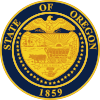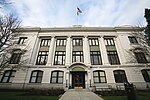
A | B | C | D | E | F | G | H | CH | I | J | K | L | M | N | O | P | Q | R | S | T | U | V | W | X | Y | Z | 0 | 1 | 2 | 3 | 4 | 5 | 6 | 7 | 8 | 9
The Oregon Portal
Oregon (/ˈɒrɪɡən, -ɡɒn/ ORR-ih-ghən, -gon) is a state in the Pacific Northwest region of the United States. Oregon is a part of the Western United States, with the Columbia River delineating much of Oregon's northern boundary with Washington, while the Snake River delineates much of its eastern boundary with Idaho. The 42° north parallel delineates the southern boundary with California and Nevada. The western boundary is formed by the Pacific Ocean. Oregon has been home to many indigenous nations for thousands of years. The first European traders, explorers, and settlers began exploring what is now Oregon's Pacific coast in the early to mid-16th century. As early as 1564, the Spanish began sending vessels northeast from the Philippines, riding the Kuroshio Current in a sweeping circular route across the northern part of the Pacific. In 1592, Juan de Fuca undertook detailed mapping and studies of ocean currents in the Pacific Northwest, including the Oregon coast as well as the strait now bearing his name. The Lewis and Clark Expedition traversed Oregon in the early 1800s, and the first permanent European settlements in Oregon were established by fur trappers and traders. In 1843, an autonomous government was formed in the Oregon Country, and the Oregon Territory was created in 1848. Oregon became the 33rd state of the U.S. on February 14, 1859. Today, with 4.2 million people over 98,000 square miles (250,000 km2), Oregon is the ninth largest and 27th most populous U.S. state. The capital, Salem, is the third-most populous city in Oregon, with 175,535 residents. Portland, with 652,503, ranks as the 26th among U.S. cities. The Portland metropolitan area, which includes neighboring counties in Washington, is the 25th largest metro area in the nation, with a population of 2,512,859. Oregon is also one of the most geographically diverse states in the U.S., marked by volcanoes, abundant bodies of water, dense evergreen and mixed forests, as well as high deserts and semi-arid shrublands. At 11,249 feet (3,429 m), Mount Hood is the state's highest point. Oregon's only national park, Crater Lake National Park, comprises the caldera surrounding Crater Lake, the deepest lake in the United States. The state is also home to the single largest organism in the world, Armillaria ostoyae, a fungus that runs beneath 2,200 acres (8.9 km2) of the Malheur National Forest. (Full article...) Selected article -
The Hillsboro Central/3rd Avenue Transit Center station is an American light rail station and transit center on the MAX Blue Line in Hillsboro, Oregon. Opened in 1998, the red-brick station is the 19th stop westbound on the Westside MAX, one stop from the western terminus of the line at the Hatfield Government Center. Physically the largest station on the westside line, it is located at a former stop of the Oregon Electric Railway and includes artwork honoring the history of the community. Located on Southwest Washington Street between Third and Fourth avenues in downtown Hillsboro, the transit center is served by four bus lines. At opening the Hillsboro Public Library operated a small branch at the station called Books by Rail, but the branch library was closed in 2003. Artwork at the stop includes a weather vane, historic photographs, and a cast bronze burden basket among other items. Inspiration and materials for the artwork were collected from the Washington County Museum, the Washington County Fair, and the Oregon Historical Society.
Selected biography -
Betty Cantrell Roberts (1923–2011) was a politician and judge in the U.S. state of Oregon. She was the 83rd Associate Justice of the Oregon Supreme Court, the highest state court in Oregon. She was the first woman on the Oregon Supreme Court, and had also been the first woman on the Oregon Court of Appeals. Roberts served from 1982 to 1986 on the high court and from 1977 to 1982 on the Court of Appeals. Roberts was born in Texas in 1923, growing-up in that state during the Great Depression of the 1930s. After attending Texas Wesleyan College for one year starting in 1941, she married and left school, eventually moving to Oregon. In 1958, Roberts earned a bachelor of science degree from Portland State University, followed by a masters degree at the University of Oregon, and in 1966, a JD from Lewis & Clark Law School. In 1964, Roberts the Democrat won election to the Oregon House of Representatives, serving until 1968 when she was elected to the Oregon Senate. During the 1975 legislature, Betty served in the Senate where both her step-daughter Mary Wendy Roberts and then-husband Frank L. Roberts also served. She was married three times, including to Frank and later to Keith Skelton, whom she would also serve with in the Oregon Legislature. Roberts lost her bid to become Oregon's governor in 1974, losing in the primary election, and then lost a campaign to become a United States Senator in the fall election. Then in 1977, Oregon Governor Robert W. Straub appointed Betty Roberts as the first woman to the Oregon Court of Appeals. In 1982, Governor Victor G. Atiyeh appointed her as the first woman to the Oregon Supreme Court where she served until 1986. She was a private mediator and senior judge until her death due to pulmonary fibrosis.
In this month
More did you know -
Did you know (auto-generated) -
General images -The following are images from various Oregon-related articles on Wikipedia.
Selected image - The Willamette Valley is the region in northwest Oregon in the United States that surrounds the Willamette River as it proceeds northward from its emergence from mountains near Eugene to its confluence with the Columbia River at Portland. Being a productive agricultural area, the valley was the destination of choice for the emigrants on the Oregon Trail in the 1840s. Selected quote -Selected panorama -Main topicsFeatured content | ||||||||||


















